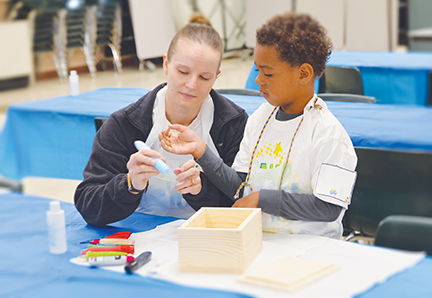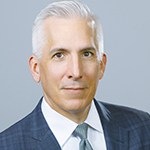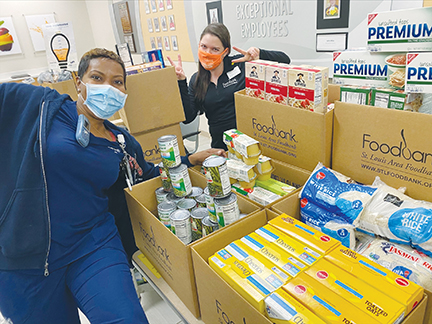By JULIE MINDA
When philanthropy and community benefit practitioners within a health system unite, they can increase their work's efficiency, tap into new resources, draw on one another's expertise and have greater impact in their communities.
Community benefit and philanthropy leaders at Avera Health, Providence St. Joseph Health and SSM Health say their systems are particularly intentional about marrying their philanthropic and community benefit efforts aimed at such priorities as behavioral
health, health equity and social determinants of health.
 Koller
Koller"We can have a tremendous impact on the people we serve … when we are all pushing in the same direction," says Sandy Koller, chief philanthropy officer of SSM Health.
Centralization
Philanthropy teams raise funds from individuals and organizations and have historically been more focused on capital projects, medical equipment purchases and other initiatives deemed important for advancing
patient care rather than improving population health. Generally speaking, community benefit teams use operating revenue and external grants to address population health and social determinants of health in marginalized neighborhoods and among vulnerable
populations. Community benefit programs are commonly undertaken as partnerships with other nonprofits.
 A volunteer helps a camper decorate a memory box at Camp GLOW, a grief support day camp in Waunakee, Wisconsin. Attendance is free thanks to the support of donors to the SSM Health at Home Foundation of Wisconsin. GLOW stands for Giving Loved Ones
Wings.
A volunteer helps a camper decorate a memory box at Camp GLOW, a grief support day camp in Waunakee, Wisconsin. Attendance is free thanks to the support of donors to the SSM Health at Home Foundation of Wisconsin. GLOW stands for Giving Loved Ones
Wings.
In the past, systems and their facilities often pursued philanthropy and community benefit work on separate tracks. But increasingly, as many national ministry systems centralize functions to take advantage of efficiencies and collective expertise, silos
are breaking down and a top-down/bottom-up flow of ideas is encouraged.
Philanthropic/community benefit twinning is becoming more the norm. At Avera, Providence and SSM Health, system-level experts in philanthropy and community benefit aim to provide strategic guidance and support to their counterparts at the local level.
This includes encouraging them to collaborate across divisions as they pursue their systems' strategic priorities while also attending to needs that are specific to their markets.
 Berberovic
BerberovicDoing the most good
Dzenan Berberovic, Avera's chief philanthropy officer, says Avera's 37 hospitals across the Great Plains still retain agency and decision-making power, including when it comes to their philanthropy
work and they provide input when it comes to decisions around their community benefit work. There's increased focus systemwide on ensuring that all the facilities do is very directly connected with Avera's strategic plan. Top needs as defined in the
strategic plan are improving access to medical and behavioral health care, affordable housing, transportation, education and healthy food.
"When efforts are aligned … we can do our work more effectively," says Berberovic.
 Meyers
MeyersLindsey Meyers, Avera vice president of public relations, adds that partnering with the philanthropy division exposes the community partnerships team to different perspectives. This intelligence is invaluable, she says, particularly when the donor community's
priorities for such worthy causes as improving mental health care access, advancing health equity and improving population health dovetail with a community benefit team's determination of unmet community needs.
 Cancer care is one of the many priority areas that Providence St. Joseph Health's philanthropy and community benefit teams are addressing in tandem. Before the pandemic, one way a Providence hospital philanthropy team raised money for complimentary
cancer wellness programming was through a fashion show benefit featuring cancer patients as models.
Cancer care is one of the many priority areas that Providence St. Joseph Health's philanthropy and community benefit teams are addressing in tandem. Before the pandemic, one way a Providence hospital philanthropy team raised money for complimentary
cancer wellness programming was through a fashion show benefit featuring cancer patients as models.Meyers notes that health systems are under great financial strain now and it is imperative that they spend community benefit money, grants and gifts to maximum effect. Having all divisions work together on the same priorities helps ensure this.
Regional structure
When Dr. Alexander Garza moved from chief medical officer of SSM Health to the system's chief community health officer about 2 ½ years ago he set about deepening the system's focus on social
determinants of health, equity and social justice and supporting its pivot to population health and value-based delivery.
 Garza
GarzaLately, Garza has been ensuring that he and staff engage in community health programming at the regional level. Food access, housing and community economic empowerment have been at the top of the agenda.
Community health teams' research and insights have led to greater understanding of what is driving the biggest concerns that vulnerable community members have, what the disparities are, and what the inequities are, says Garza.
Koller says the community health team has the intelligence and data on the major disparities in the communities that SSM Health's 23 Midwestern hospitals serve, and that is the type of information donors want so they can ensure their dollars are going
toward the communities' top needs. She says, "The community health team are the subject matter experts, they have the experience, and they know through research what the greatest needs are. They have the pulse." With information from that group,
"we can help donors make the greatest impact. And donors expect that of us — that we understand how to make the greatest impact."
Koller adds that SSM Health has seen that donors want their contributions to make a difference. Contributions to improve behavioral health, advance health equity and address food insecurity fit that bill.
 Beckmann
BeckmannConvergence
Kenya Beckmann is chief philanthropy officer of the south division of Providence, which covers the California facilities within the 52-hospital system. She says to encourage greater synergy between the
community benefit and philanthropy teams, Providence in California has organized both of those functions in the same reporting chain. In her newly created position for Providence's southern region, Beckmann oversees philanthropy and community
health investment, which is Providence's community benefit division. Health equity also falls within her reporting chain.
 Colleagues at SSM Health DePaul Hospital — St. Louis box up items to restock a community food pantry in November. SSM Health's community benefit and philanthropy teams work in partnership to address food insecurity.
Colleagues at SSM Health DePaul Hospital — St. Louis box up items to restock a community food pantry in November. SSM Health's community benefit and philanthropy teams work in partnership to address food insecurity. Beckmann says, "The community has pushed us to articulate ourselves differently, with fewer silos. (Donors and community partnering agencies) wanted us to have a coherent strategy that was clearly working toward the common good" — and that is
what Providence wanted as well, she says. Ensuring community benefit and philanthropy are in sync with one another furthers this goal.
She says health care is in an era of scarcity, and "philanthropy can change the DNA of an organization" in lean times. Philanthropy can give organizations the funds they need to take necessary risks.
Beckmann says she "loves that philanthropy and community benefit are coming together more. The community's fate is bound with ours and we want to be trusted partners" in addressing what's important to community members. Convergence helps achieve this,
she says.
Philanthropy, community benefit working together to address behavioral health, social determinants, disparity
Ministry systems increasingly are ensuring that their philanthropy and community benefit work is aligned and directed toward top strategic goals. A sampling of the programming that these divisions are partnering on at three Catholic health
systems includes:
Avera Health
Behavioral health: Community health needs assessments have surfaced behavioral health as a pressing concern for the Great Plains communities where Avera operates. Avera's community partnership
and philanthropy divisions have prioritized behavioral health. The community partnership group has joined with nonprofits to educate community members on mental health and to conduct suicide prevention campaigns. And the philanthropy division
has raised funds to expand Avera's behavioral health hospital in Sioux Falls, South Dakota, and to fund its patient support programs. This includes a grassroots marketing campaign to prevent deaths by suicide.
Providence St. Joseph Health
Workforce development: Philanthropy and community benefit teams are both undertaking efforts to build up the pipeline of workers. One community benefit program that has received
philanthropic support exposes students from minority communities to career opportunities in health care. Philanthropists also have helped fund nursing scholarships.
Behavioral health: Community benefit and philanthropy teams have worked together to support trauma informed health care training, mental health first aid courses and substance misuse care navigation in Providence markets.
SSM Health
Community economic empowerment: Philanthropy and community benefit teams have partnered on programs to promote hiring from disadvantaged communities in SSM Health's service areas.
Food insecurity: Programming includes screenings that surface and seek to address food insecurity concerns among patients, partnerships with local pantries and initiatives to ensure at-risk pregnant women have sufficient nutrition.